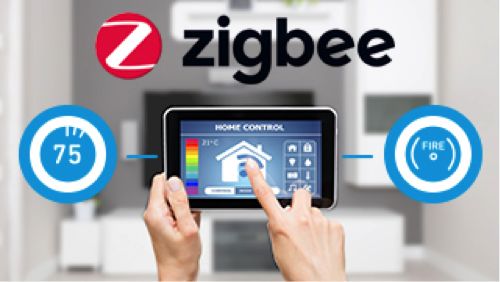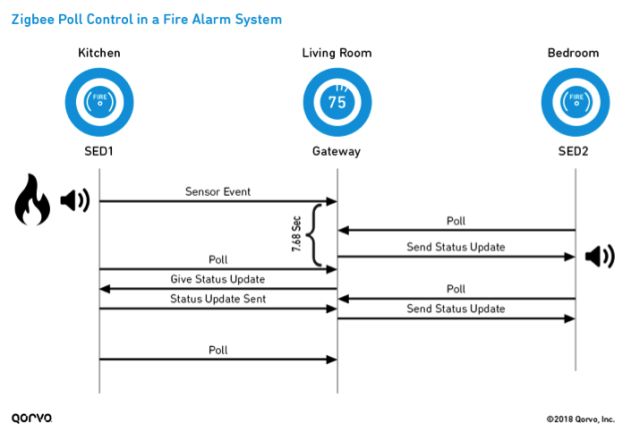Glossary
• ACK: Confirmation
• MAC: Media Access Control
• SED: Sleep Terminal
• ZCL: Zigbee Cluster Library
Understanding the polling features in the Zigbee standard helps optimize the power consumption of Internet of Things (IoT) products. Let's take a closer look at Zigbee's polling mechanism and use the fire alarm sensor application as an example.
Recently, due to its own energy-efficient features, the three Zigbee wireless protocols (Zigbee 3.0, Zigbee PRO and Green Power) received the 2017 SEAD Connectivity Efficiency Award. In particular, Zigbee 3.0 provides application-level features that focus on energy management, including power configuration, polling control, device aging management, battery monitoring, and energy-saving network traffic reduction strategies.
Understanding the polling features in the Zigbee standard helps optimize the power consumption of Internet of Things (IoT) products. This blog post will further explore the polling mechanism in Zigbee and its use in fire alarm sensors.

Q
What is polling?
Polling is a mechanism by which the Zigbee gateway can continuously check the status of the relevant terminal sensor device. A low-power Zigbee sensor is called a Sleep End Device (SED) and is only "activated" when an event generated by the sensor is sent. In addition, they also ensure that the sensor network is operational by periodically sending reports to the gateway.
Polling is a media access control (MAC) data request generated by the SED. The gateway in the Zigbee network acknowledges this request by sending an ACK (acknowledgement) message. In addition, the gateway can decide to further extend polling to send any messages stored for the SED or to read sensor events.
Polling type in the Zigbee standard
The Zigbee standard defines two basic types of polling:
• Short polling
• Long polling
The SED uses an extended polling scheme (such as fast polling and check-in) to send or receive messages from the gateway.
Short polling
The SED can begin short polling, during which the SED performs a high duty cycle MAC data request to retrieve messages it requests from other end devices. As shown in the figure below, SED1 sends a data request to SED2 through the gateway. SED1 then continuously polls the gateway to receive responses from SED2. At this point, SED1 is considered to be in "Fast Polling Mode", which continues until the "Fast Polling Timeout" period ends or the SED receives a "Fast Polling Stop" command from the gateway.
Long polling
Long polling allows the SED to periodically report to its gateway. These are low duty cycle MAC data requests. They also provide an opportunity for the SED to retrieve messages from the gateway. Gateway:
• Store the message for 7.68 seconds
• By setting the data pending flag in the ACK to high, indicating that a message has been sent to the SED, as shown in the following figure
• Then, send the message as a MAC packet to the SED
Sign-in event
The sign-in event is a very low duty cycle event generated by the Zigbee application layer through Zigbee Cluster Library (ZCL) transactions. During the check-in period, the SED can receive data from the gateway, which typically takes longer than the defined 7.68 seconds. The gateway can then initiate a fast polling mode, in which the gateway can send data until the end of fast polling (or until the gateway sends a "fast polling stop" command). The gateway can also update the polling control parameters during the check-in event. The check-in event is ideal for performing firmware updates or collecting diagnostic data from sensors. As shown in the following figure, the gateway sends a ZCL read attribute command during the fast polling phase of the check-in. The SED replies with "ZCL Read Response".

How does polling work?
For example: Let's look at an example of using a fire alarm sensor in real life. In this example, intelligent polling options can save lives. The technical manual for the Develco Commercial Smoke Alarm Product (SMSZB-120) provides the following default polling control settings for its sensors:
Polling control attribute
Check-in interval
Long polling interval
Short polling interval
Fast polling timeout
Default polling control settings
1 hour
7.5 seconds
1 second
5 minutes
Let's take the example of two Zigbee fire alarm sensors in the kitchen and bedroom, which we call SED1 and SED2. Both sensors communicate with the same Zigbee gateway (in this case, an intelligent thermostat). The SED1 detects a rapid rise in heat and smoke in the kitchen, then issues an alarm and sends an update to the gateway to the gateway. At the same time, the SED2 in the bedroom still does not detect the heat or smoke from the kitchen. So how can the gateway quickly update the fire alarm in the bedroom to send out an alarm message?

When SED1 detects a fire, it will immediately start and send an alarm event message to the gateway. The message will be stored in the gateway for 7.68 seconds. The gateway can then send an update to it when it receives a long polling data request from SED2. If our Develco Fire Alarm sample uses the above default settings, the SED2 in the bedroom will be able to sound an alarm in less than 7.5 seconds. The gateway may request SED1 to send a status update message each time a long polling event occurs and forward the information to SED2.
ZigBee: Helps improve energy efficiency
The polling mechanism in Zigbee is just one part of helping Zigbee IoT systems save energy. Stay tuned for our blog post and we'll explore the battery monitoring and sub-aging mechanisms in the Zigbee standard.
Withstand high voltage up to 750V (IEC/EN standard)
UL 94V-2 or UL 94V-0 flame retardant housing
Anti-falling screw
Optional wire protection
1~12 poles, dividable as requested
Maximum wiring capacity of 4 mm2
4 mm2 Terminal Blocks,high quality terminal strips,high performance terminal barriers,BELEKS T04 series terminal connectors,3 amp connector strips
Jiangmen Krealux Electrical Appliances Co.,Ltd. , https://www.krealux-online.com
![<?echo $_SERVER['SERVER_NAME'];?>](/template/twentyseventeen/skin/images/header.jpg)